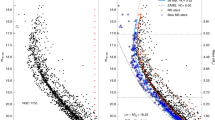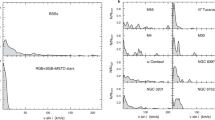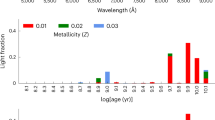Abstract
Blue straggler stars lie on or near the main sequences of star clusters (all members of which formed around the same time), but typically are more luminous than the turn-off stars and therefore long ago should have evolved off the main sequence to become giants and white dwarfs. They are thought to derive from normal main-sequence stars that have undergone a recent increase in mass. Statistical evidence indicates that in globular star clusters the blue stragglers probably form from binary stars1. The specific formation processes, such as mass transfer, mergers or stellar collisions during dynamical encounters of binary stars, remain unresolved. Here we report that 16 of the 21 blue stragglers (76 per cent) in the old (7-Gyr; ref. 2) open cluster NGC 188 are currently in binary systems, a frequency three times that found among normal solar-type main-sequence stars. These blue straggler binaries have a remarkable period–eccentricity distribution, with all but three having orbital periods of ∼1,000 days. Moreover, these stars are rotating faster than normal main-sequence stars of the same surface temperatures. These data show that most, and possibly all, blue stragglers derive from multiple-star systems, and indicate that the several formation processes operate simultaneously. We suggest that rapid rotation of blue stragglers may place upper limits on their ages.
This is a preview of subscription content, access via your institution
Access options
Subscribe to this journal
Receive 51 print issues and online access
$199.00 per year
only $3.90 per issue
Buy this article
- Purchase on Springer Link
- Instant access to full article PDF
Prices may be subject to local taxes which are calculated during checkout



Similar content being viewed by others
References
Knigge, A., Leigh, N. & Sills, A. A binary origin for ‘blue stragglers’ in globular clusters. Nature 457, 288–290 (2009)
Sarajedini, A., von Hippel, T., Kozhurina-Platais, V. & Demarque, P. WIYN Open Cluster Study. II. UBVRI CCD photometry of the open cluster NGC 188. Astron. J. 118, 2894–2907 (1999)
Geller, A. M., Mathieu, R. D., Harris, H. C. & McClure, R. D. WIYN Open Cluster Study. XXXII. Stellar radial velocities in the old open cluster NGC 188. Astron. J. 135, 2264–2278 (2008)
Platais, I., Kozhurina-Platais, V., Mathieu, R. D., Girard, T. M. & van Altena, W. F. WIYN Open Cluster Study. XVII. Astrometry and membership to V = 21 in NGC 188. Astron. J. 126, 2922–2935 (2003)
Mathieu, R. D. in Stellar Clusters and Associations: Convection, Rotation and Dynamos (eds Pallavicini, R., Micela, G. & Sciortino, S.) 517–531 (Astron. Soc. Pacif. Conf. Ser. 198, Astronomical Society of the Pacific, 2000)
Geller, A. M., Mathieu, R. D., Harris, H. C. & McClure, R. D. WIYN Open Cluster Study. XXXVI. Spectroscopic binary orbits in NGC 188. Astron. J. 137, 3743–3760 (2009)
Duquennoy, A. & Mayor, M. Multiplicity among solar-type stars in the solar neighbourhood. II. Distribution of the orbital elements in an unbiased sample. Astron. Astrophys. 248, 485–524 (1991)
Meibom, S. & Mathieu, R. D. A robust measure of tidal circularization in coeval binary populations: the solar-type spectroscopic binary population in the open cluster M35. Astrophys. J. 620, 970–983 (2005)
Girardi, L. et al. Theoretical isochrones in several photometric systems. I. Johnson-Cousins-Glass, HST/WFPC2, HST/NICMOS, Washington, and ESO Imaging Survey filter sets. Astron. Astrophys. 391, 195–212 (2002)
Latham, D. W. Spectroscopic binaries in M67. Highlights Astron. 14, 444–445 (2007)
Milone, A. A. E. & Latham, D. W. in Evolutionary Processes in Interaction Binary Stars (eds Kondo, Y., Sisteró, R. F. & Polidan, R. S.) 475–478 (Proc. IAU Symp. 151, Springer, 1992)
Sills, A., Adams, T. & Davies, M. B. Blue stragglers as stellar collision products: the angular momentum question. Mon. Not. R. Astron. Soc. 358, 716–725 (2005)
Portegies Zwart, S., Hut, P., McMillan, S. L. W. & Verbunt, F. Star cluster ecology II. Binary evolution with single-star encounters. Astron. Astrophys. 328, 143–157 (1997)
Mermilliod, J.-C. & Mayor, M. in Binaries as Tracers of Stellar Formation (eds Duquennoy, A. & Mayor, M.) 183–201 (Cambridge Univ. Press, 1992)
Mathieu, R. D., Latham, D. W. & Griffin, D. W. Orbits of 22 spectroscopic binaries in the open cluster M67. Astron. J. 100, 1859–1881 (1990)
Perets, H. B. &. Fabrycky, D. C. On the triple origin of blue stragglers. Astrophys. J. 697, 1048–1056 (2009)
Sandquist, E. L., Latham, D. W., Shetrone, M. D. & Milone, A. A. E. The blue straggler RS Canum Venaticorum star S1082 in M67: a detailed light curve and the possibility of a triple. Astron. J. 125, 810–824 (2003)
van den Berg, M., Orosz, J., Verbunt, F. & Stassun, K. The blue straggler S1082: a triple system in the old open cluster M 67. Astron. Astrophys. 375, 375–386 (2001)
Carney, B. W., Latham, D. W., Laird, J. B., Grant, C. E. & Morse, J. A. A survey of proper-motion stars. XIV. Spectroscopic binaries among metal-poor field blue stragglers. Astron. J. 122, 3419–3435 (2001)
Hurley, J. R., Tout, C. A. & Pols, O. R. Evolution of binary stars and the effect of tides on binary populations. Mon. Not. R. Astron. Soc. 329, 897–928 (2002)
Hurley, J. R., Pols, O. R., Aarseth, S. J. & Tout, C. A. A complete N-body model of the old open cluster M67. Mon. Not. R. Astron. Soc. 363, 293–314 (2005)
Kraft, R. P. Studies of stellar rotation. V. The dependence of rotation on age among solar-type stars. Astrophys. J. 150, 551–570 (1967)
Skumanich, A. Time scales for Ca II emission decay, rotational braking, and lithium depletion. Astrophys. J. 171, 565–567 (1972)
Meibom, S. in The Ages of Stars (eds Mamajek, E. E., Soderblom, D. R. & Wyse, R. F. G.) 357–362 (Proc. IAU Symp. 258, Cambridge Univ. Press, 2009)
Mathieu, R. D., Meibom, S. & Dolan, C. J. WIYN Open Cluster Study. XVIII. The tidal circularization cutoff period of NGC 188. Astrophys. J. 602, L121–L123 (2004)
Mazeh, T. Eccentric orbits in samples of circularized binary systems: the fingerprint of a third star. Astron. J. 99, 675–677 (1990)
Acknowledgements
We thank the staff of the WIYN Observatory and the many graduate and undergraduate students who have assisted in observing NGC 188. The WIYN Observatory is a joint facility of the University of Wisconsin–Madison, Indiana University, Yale University and the US National Optical Astronomy Observatories. We thank D. Fabrycky, J. Hurley, N. Leigh, H. Perets and A. Sills for their comments. This work was funded by the US National Science Foundation grant AST-0406615 and the Wisconsin Space Grant Consortium.
Author Contributions R.D.M. and A.M.G. contributed equally to this work.
Author information
Authors and Affiliations
Corresponding author
Supplementary information
Supplementary Information
This file contains a Supplementary Discussion and Supplementary References. (PDF 133 kb)
Rights and permissions
About this article
Cite this article
Mathieu, R., Geller, A. A binary star fraction of 76 per cent and unusual orbit parameters for the blue stragglers of NGC 188. Nature 462, 1032–1035 (2009). https://doi.org/10.1038/nature08568
Received:
Accepted:
Issue Date:
DOI: https://doi.org/10.1038/nature08568
This article is cited by
-
UVIT/AstroSat studies of blue straggler stars and post-mass transfer systems in star clusters: detection of one more blue lurker in M67
Journal of Astrophysics and Astronomy (2020)
-
Photometric analysis of a blue straggler eclipsing binary in the old open cluster NGC 2141
Science China Physics, Mechanics and Astronomy (2012)
-
Stars acquire youth through duplicity
Nature (2011)
-
A mass transfer origin for blue stragglers in NGC 188 as revealed by half-solar-mass companions
Nature (2011)
Comments
By submitting a comment you agree to abide by our Terms and Community Guidelines. If you find something abusive or that does not comply with our terms or guidelines please flag it as inappropriate.



